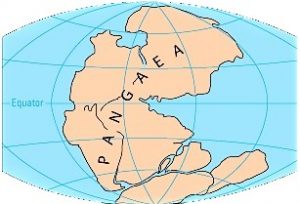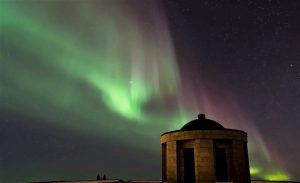Atmosphere
The atmosphere is a gas layer that surrounds a celestial body. These gases are attracted thanks to the bodies' gravity and in that way, they manage to stay in it if the force of gravity is sufficient and the temperature of the atmosphere is low. It is approximately 10,000 km thick and we find it around the lithosphere and the hydrosphere at the same time. It is made up of solid and liquid particles in a suspension state besides the gases included in it, which are attracted by terrestrial gravity. The earth is not the only one that has atmosphere, we can see it in other planets like Mercury, Venus, Mars, Pluto, Uranus and even the sun.

Related topics
Asthenosphere, exosphere, hydrosphere, lithosphere, mesosphere, thermosphere, troposphere
What is the atmosphere?
A layer formed of gas, solid and liquid particles that are in a state of suspension, which are attracted by the Earth's gravity. It is found surrounding the lithosphere and the hydrosphere. The atmosphere is where all the climatic and meteorological phenomena that we see around us happen and that produce constant changes in our planet.
Characteristics of the atmosphere
Among the main characteristics of the atmosphere we can mention the following:
- Its total mass is 5.1 x 1015 kg, however, that amount is variable according to the amount of water vapor in it, time and place also affects the amount.
- Its density is related to altitude, so the higher the altitude, the lower the density.
- Factors such as temperature, humidity, environment, are factors that directly influence the atmosphere.
- The atmosphere is divided into different layers, classified and named according to their variation in temperature and atmospheric pressure, creating a scale called thermal-atmospheric gradient.
Atmosphere composition
It consists mainly of gases, nitrogen and oxygen, ozone and carbon dioxide. At the same time, we can find a large amount of water vapor in it. Atmosphere composition varies, because living beings also release and consume some types of gases that are in direct contact with the atmosphere.
Functions
The atmosphere has important and vital life functions. It allows biochemical cycles to be adequate when it correctly supplies gases that are indispensable for life. It is responsible for preventing heat leaks and acts as a shield against meteorites, because they disintegrate when they come into contact with atmospheric air. It gives us important protection against solar radiation, without it we would be totally exposed to ultraviolet rays that are extremely harmful to living beings, to space objects that could collide with earth and to important and dramatic variations in temperature and climate during the day and night. The oxygen is vital to our organism, and necessary to be able to complete basic life functions.
Atmosphere types
The atmosphere is divided into different layers, which vary according to temperature and pressure forming a scale called atmospheric thermal gradient. These layers are the following:
- Troposphere: It is the lower layer, located in the first 6 to 20 kilometers high. Here climatic and atmospheric phenomena
- Stratosphere: The layer goes from 20 to 50 kilometers high and is arranged in different layers or phases of air. In it the transformation of oxygen into ozone occurs thanks to ultraviolet rays.
- Ozonosphere: It produces the largest amount of ozone and is the layer responsible for protecting the planet against the direct impact of the sun’s rays, absorbing more than 95% of them and protecting against ultraviolet rays.
- Mesosphere: This is the coldest layer. It can reach temperatures as low as -80° C. It extends between 50 and 80 kilometers in height and contains only 0.1% of the total mass of atmospheric air.
- Ionosphere: It is also known as thermosphere. It goes from 90 to 800 kilometers of altitude, and its temperature increases depending on the altitude, because solar rays influence its temperature.
- Exosphere: This is the outer layer. It starts around 800 kilometers and ends at 10,000 kilometers. In this atmospheric layer atoms escape into space and is the transit zone between our planet and outer space.
Stages
The atmosphere has three different stages which are explained below:
- Prebiotic stage: The atmosphere suffered some important changes before having life, such as the condensation of water vapor that originated ocean formation and the dissolution of gases. The main gas it contains is nitrogen.
- Microbiological stage: In this stage, oxygen formation began in the ocean, which was used to oxidize substances from the ocean and the earth’s crust, in order to start the accumulation of this element in the atmosphere.
- Biological stage: The eukaryotic organisms appeared with photosynthesis. There was an increase in O2 until the current concentration of 21% was reached. It originated the formation of the O3 layer, responsible for protecting us from ultraviolet rays.
Importance
The atmosphere is extremely important for life because it protects the Earth, absorbing much of the ultraviolet solar radiation from the ozone layer. In addition, it acts as a protective shield against meteorites and other space materials, which disintegrate into dust thanks to the friction they suffer when they come into contact with air.
Atmosphere in other planets
Several planets have atmospheres, all with different characteristics:
- Venus: Its atmosphere is dense, consisting mainly of CO2 and a small amount of carbon monoxide. Its temperatures are very high and do not vary between day and night. Its winds are fast, approximately 360 km/hour.
- Mars: It is very tenuous, its pressure varies according to the altitude, composed mainly of carbon dioxide and water vapor among others. It is common to see winds and dust storms that last for months due to their density.
- Jupiter: Clouds of different colors can be observed, formed at different heights and with different compositions.
- Saturn: Saturn has different dark bands and light areas; strong winds can be found in the atmosphere following parallels direction.
- Uranus: It atmosphere is very ticked, and it is formed by a mixture of hydrogen, helium and methane, responsible for providing its characteristic color.
- Neptune: It is formed by hydrogen, helium and a small percentage of methane gas, responsible of providing it a greenish blue color. Its particles are slightly more separated than they should be because of the temperature, which is -200 °C.
How to cite this article?
Briceño V., Gabriela. (2019). Atmosphere. Recovered on 24 February, 2024, de Euston96: https://www.euston96.com/en/atmosphere/









